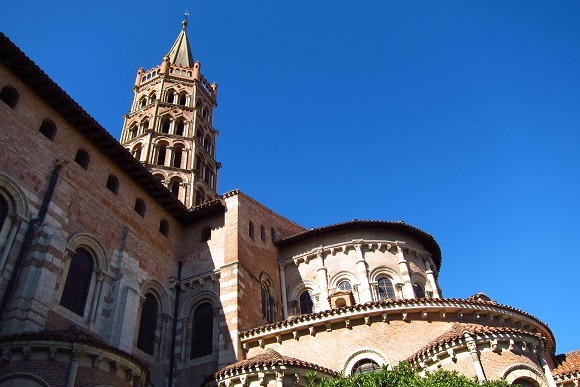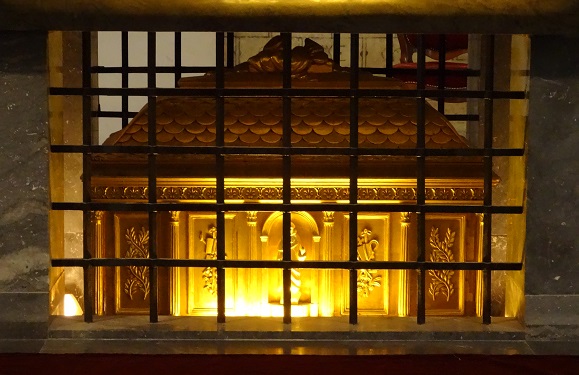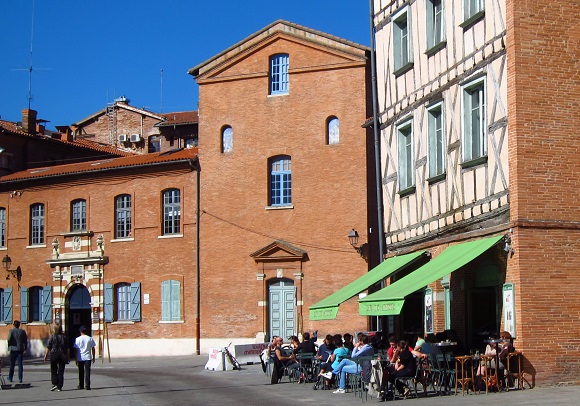
No need for tired feet when touring Toulouse. Here are select seats from which to do some sweet sight-sitting in the bright brick city with the distinctive southern accent.
I love the clichés of seaside and countryside travel in southern European. Sitting in a seaside café I’ll let the whish of waves against a pebble beach draw me into a Mediterranean daze. And pausing by a bubbling fountain on a hillside village I slide easily into a “year-in-Provence-under-a-Tuscan-sun” frame of mind. But having arrived in Toulouse, the queen of southwest France, and taken a seat on its central square, I know that at heart I’m a city traveler.
I enjoy discovering a city rich in architecture, museums, street life, and cultural events, where the trick isn’t to see it all but to explore it at my own pace. And mine’s a pace that requires frequent sitting. As far as I’m concerned, a southern city is only as great as the cafés between the sights.
Call it sight-sitting, tour operators need not apply.
Any exploration of Toulouse naturally begins on Place du Capitole, the political, historical, and cultural heart of the city as well as of France’s landlocked Midi-Pyrénées region, which stretches north from the Spanish border. Lingering in any of the half-dozen cafés around the square provides a luxuriant introduction to the two characteristics that most distinguish Toulouse: the brick and the accent.
In a country otherwise associated with constructions in stone, Toulouse has conjugated its local orange-pink brick into a surprising array of religious and civil monuments, including the 18th-century façade of Le Capitole, the building that lords over the city’s central square, housing City Hall and the Toulouse Opera.

Anywhere you sit you’ll hear the song of Toulouse’s easily recognizable, if difficultly understandable, brand of a southern French accent. I asked several Toulousans to describe it and came up with the following Zagat-like description: “our registered trademark,” “a soft stuttered delivery ending in an open-ended Occitan song,” “bright and easy,” “a verbal reflection of the brick itself.”
I was visiting in June, when the wind here hesitates between Atlantic (about 180 miles west) and Mediterranean (about 100 miles east). Arriving from Paris in the late afternoon at the tail end of an Atlantic drizzle, I took a seat within the cozy Belle Epoque interior of Le Bibent, joining a klatch of perfumed shoppers having tea.
By early evening the Mediterranean was asserting its rights on the Toulousan sky, so I later returned to Place du Capitole to see (seated, of course) how the color of the brick changes with the sky. To my eyes it never quite hits the pink note that has given Toulouse its nickname “la Ville Rose,” however it does have a bright terra cotta twinkle in the right light. I had an aperitif at Le Florida, one of the square’s most popular cafés and a clear reminder at that hour that Toulouse has France’s second largest university population after Paris.
France
From Place du Capitole, the view down rue de Taur toward the brick lacework of the bell tower of Saint Sernin Basilica is an open invitation to discover one of France’s greatest churches from the Romanesque era. On the morning of day two I headed down that road and began my sight-sitting day with coffee and a view of the basilica’s back end from a table beneath the linden trees at Café St. Sernin.
Begun in 1080, St. Sernin Basilica is the country’s longest church still in existence from the Romansque period, which preceded France’s passion for Gothic monsters. The basilica’s enormity was principally a response to the throngs of pilgrims that came to venerate the relics of the city’s first bishop. As a medieval tourist attraction it further benefited being situated along major pilgrimage routes to some of the most revered relics in Western Europe at the time, those of Saint James in Santiago de Compostella in northwest Spain. Hundreds, even thousands, of pilgrims might circulate through St. Sernin’s five naves on a given day in the 12th and 13th centuries.

St. Sernin is more than a one-seat sight, so after visiting the interior I read up these medieval pilgrimages with a frontal view of the basilica from a snack bar café table beneath the ancient elm overhanging the courtyard by the Saint Raymond Museum. The St. Raymond Museum’s collection of antiquities speaks of an even earlier time as it gives glimpses of local civilization under Roman rule and during the several centuries that followed. Descriptions in English aren’t sufficient to reveal the significance of the objects to those who don’t understand French, but their beauty is apparent.
Toulouse’s second great church is the Jacobins Church, designed in 1230 and as much a monument to southern France’s Gothic architecture as St. Sernin is to its Romanesque. The Jacobins was built as the mother church of the Dominican order of preaching friars that was founded in the early 13th century by (Saint) Dominic. Dominic made a name for himself by preaching against a religion called Catharism, which had developed and increasingly flourished in the region in the 12th century. Catharism was a Christian off-shoot with Eastern influences whose system of belief refused the hierarchy and sacraments of the Church of Rome. The Church, finding its authority undermined and considering Cathars as heretics, initially fought back with words. When words failed, Pope Innocent III, in 1209, called for a crusade against the heretics, launching the Albigensian War. The bloodletting was orchestrated by French noblemen while the Dominicans led the accompanying inquisition, and together they wiped out the Cathars, whose final hill refuges can be seen when heading toward the Pyrenees.
Lit by daylight through beautiful stained glass, the Jacobins Church is split into two naves by seven stone columns that blossom to the ceiling like palm fronds. The relics of St. Thomas Aquinas (1225-1274) stand as the centerpiece in an otherwise attractively sparse church, yet nowadays, as with the relics at St. Sernin, those of St. Thomas are passed by with less interest than a third-rate Picasso.

No café gives an adequate view of the Jacobins, but the adjacent 14th-century cloister did just fine for me. A small entrance fee keeps it especially peaceful and calm as well as friendly, I found, since its rare visitors tend to smile at each other in passing as though they’d just discovered they belong to the same exclusive club of unhurried travelers.
Toulouse has three exceptional settings for art, beginning with the 14th- and 15th-century cloister and monastic buildings of another religious complex, the Augustins. This was the perfect place to end a day my day of medieval explorations. The brick walls and Gothic rib vaults serve as stunning backdrops for the Augustins Museum’s exceptional collection of medieval sculpture and religious painting.
Place Saint Georges, a block away, offers the cafés of choice for that area of the city—and, to judge by the crowds, for many other areas as well. On warm days and nights seats are so hard to come by that you’d think the city were about to stage an execution, as it did on this square throughout the 18th century.
Toulouse is the rare French city that you can visit for a few days without bothering to have a peek at the cathedral. St. Etienne Cathedral, a 5-minute walk from Place Saint Georges, is noteworthy primarily as an architectural junk pile. I visited it out of a sense of investigative responsibility, but less duty-bound travelers should feel free, instead, to take a 5-minute stroll in the opposite direction so as to continue sight-sitting from a café on Place Wilson. A good part of late afternoon can actually be spent trolling for dinner menus on Place Saint Georges, Place Wilson, and nearby Place Victor Hugo.
On day three I left behind the monuments of medieval Toulouse to explore its unique assortment of brick mansions from the 16th to the 18th centuries. Toulouse counts dozens such mansions, so you shouldn’t hesitate to push open a large door, walk through the arched passageway, and glimpse the inner courtyard, where the height of a man’s wealth was measured by the height of the tower rising above the central staircase. The earlier of these homes reflect the remarkably rich period when the city flourished with the pastel trade, in which woad plants were cultivated in the surrounding region for a blue pigment then used in dyes throughout Europe.

The most impressive of these is the great Renaissance Hôtel d’Assézat (hôtel means a city mansion), begun in 1555, which was extensively restored in the 1990s so as to house the equally impressive private art collection of Georges Bemberg. The tremendous and eclectic collection of the Fondation Bemberg is especially rich in French Modernist works from the late 19th and early 20th centuries (Impressionists, Pointillists, Fauves, and an astounding grouping 35 works by Bonnard). I’m also particularly fond of the characters revealed the Renaissance gallery, whose works include Lucas Cranach’s seductive “Portrait of a Lady,” and his playfully erotic “Venus and Cupid.” My need for an artful sit, catalogue in hand, was easily satisfied at to the tearoom (open May-Oct.) on the porch overlooking the mansion’s inner courtyard.
That afternoon I strolled across the river to Les Abattoirs, the city’s former slaughterhouse (1831), which has been successfully and surprisingly transformed into a contemporary arthouse. Its collection is devoted to currents since 1950, particularly the works of French, Italian, and Spanish artists. As with the Augustins Museum, part of the distinctiveness of Les Abattoirs is the unusual experience of viewing art against a brick background.
A more stunning view of Toulousan brick, however, lay just ahead. I came up it while crossing over the Garonne River on the elegant bridge Pont Neuf (1544-1662) on my way back to the city center. It was about an hour before sunset and the high terra cotta riverbanks, the water, and the lovers along the riverside footpath all sparkled in a spectacular natural light show.
For the first time in several days I thought about following the river or some other path into the countryside. I knew that within a two-hour drive of Toulouse I would find a stunning constellation of market towns, goose farms, castle ruins, abbey churches, gastronomic hideaways, and assorted villages set high and low along the meandering rivers.
But I still had more city sight-sitting to do, from a bench along the river.
© 2005, 2008 by Gary Lee Kraut
Useful Links
Toulouse Tourist Office. The Tourist Office is behind City Hall, just off Place du Capitole. Postal address BP 0801, 31080 Toulouse Cedex. Tel 05 61 11 02 22.www.ot-toulouse.fr.
Midi-Pyrénées (regional) Tourist Office. www.tourisme-midi-pyrenees.com. 54 boulevard de l’Embouchure, 31022 Toulouse. Tel 05 61 13 55 55.
American Present Post in Toulouse. 25 allée Jean Jaurès. Tel. 05 34 41 36 50. https://fr.usembassy.gov/embassy-consulates/toulouse/.
Americans in Toulouse, a service and social organization for “English-speaking ex-pats living and sharing the good life in Toulouse, France.”www.americansintoulouse.com.
Hôtel d’Assézat/The Bemberg Foundation www.fondation-bemberg.fr.
Les Abattoirs/Museum of Modern and Contemporary Art, www.lesabattoirs.org.
Culture, Sports, Festivals
High culture: The Théâtre du Capitole presents opera, ballet, operettas, and recitals by nationally and internationally known performers. www.theatre-du-capitole.org.
Rugby: Southwest France is rugby territory. The professional season runs mid-August through May. For information about the local team Stade Toulousain and its schedule of home matches see www.stadetoulousain.fr. Place Saint Pierre is home to a scrum of rugby café-bars.
Rio Loco: Each June a joyous festival of music, theater, dance, and exhibitions honors a great river and the culture along its banks. www.rio-loco.org.
Piano des Jacobins: Each September, an international piano festival in the cloister of the Jacobins Church. www.pianojacobins.com.
Toulouse les Orgues: Annual organ festival in the first two weeks of October. www.toulouse-les-orgues.org.

